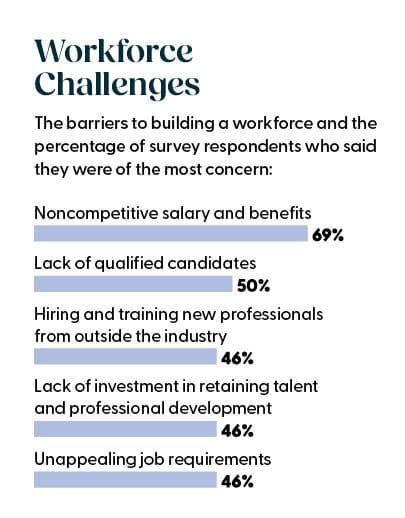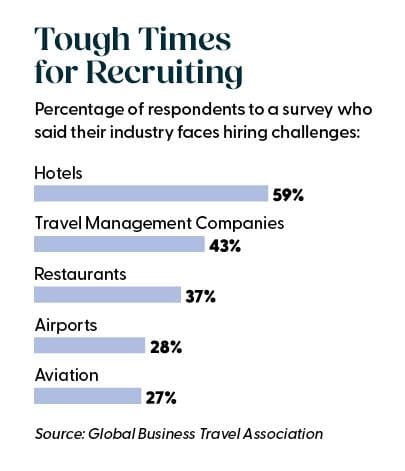)
Hospitality Industry Tackles Labor Shortage with Training, Recruiting Efforts
Editor’s note: This article first published in the June 2023 Special Edition of Beyond the Meeting Room, ALHI’s printed magazine, a luxury lifestyle publication focused on sharing compelling, inspirational and educational stories from beyond the four walls of a meeting room.
With global tourism at 80% of pre-pandemic levels as of the first quarter of 2023, according to the U.N.’s World Tourism Organization, hotels and hospitality organizations are doubling down on workforce training and development. They’re doing everything from cross-training front-line employees so they can backstop colleagues to training supervisors in managing Generation Z, often building on existing programs and making them stronger.
“Employers have really started investing in people,” said Altaf Sovani, founder and CEO of Alzen Consulting, specializing in the hospitality, tourism and event industry, and author of the book “Labor Crisis in Hospitality, Tourism and Event Industry.” “They’re realizing after the pandemic their biggest asset is employees.”


Training and Development
The efforts run the gamut. There’s Hilton Worldwide University, where the 300,000-person company provides online training through more than 2,500 courses—in the form of classroom training, e-learning, webinars, e-books, live and taped programs and other efforts.
At Marriott, the Voyage Global Leadership Development Program offers 12 to 18 months of training to future leaders across its brands in various disciplines—such as accounting and finance, culinary, and engineering—offering departmental rotations and social collaboration with colleagues around the world through social learning tools.
And at Hyatt, the Corporate Management Trainee Program offers six-week rotations through several departments of the hotel. And many other chains and properties are doing their best to keep up.
We have a very small workforce right now, and everyone is struggling.” Altaf Sovani, Founder and CEO, Alzen Consulting
What’s Driving the Effort?
Staffing shortages are driving some of the renewed passion. In a poll by the Global Business Travel Association in April 2023, 58% of respondents said they are experiencing labor shortages and recruitment challenges.
The organizations facing the biggest challenges are hotels (mentioned by 59% of respondents), travel management companies (43%), restaurants (37%), airports (28%) and aviation (27%), the survey found.
Other than noncompetitive salary and benefits (69%), the poll found the biggest barriers to building a sustainable workforce are a lack of qualified candidates (50%), hiring and training new professionals from outside the industry (46%), lack of investment in retaining talent and professional development (46%) and unappealing job requirements (46%).
The hardest positions to staff are in technology development (cited by 31%), entry-level operations (26%), sales and account management (24%) and travel consultants/agents (17%), according to the respondents.
The good news is that many workers are hungry to learn, and more companies are ready to engage them with educational programs.
“Everybody wants to improve their skills and be more marketable, so we’re seeing more emphasis on learning and development, and upskilling,” said Taya Paige, CMM, a strategic advisor at ITA Group, a global engagement solutions consultancy, which recently acquired the London-based experiential learning and development company NKD.
Employers are looking to get Gen Z up to speed with training that leads to certifications and badges they can add to their LinkedIn profiles. “People are looking for companies that will support their ongoing development,” Paige said.
Paige expects to see an uptick in demand for programs that help with soft skills, such as critical thinking and communicating effectively in a more digital environment.
Not All About Seniority
With understaffing an industrywide challenge, cross-training programs are picking up steam.
“They’re creating internal talent mobility,” Sovani said. “Then they’re deploying employees where their needs are. They’re pushing aside something ingrained—seniority—and focusing on things like: Can you do the work? Do you have the credentials? Do you have the right skills?”
Training managers to lead in a hybrid workplace—one where Gen Z is making its mark—is becoming more common, according to Sovani. Workers in this generation look for workplaces that embrace diversity, equity and inclusion, and climate-friendly policies.
“Organizations need to upskill supervisors, so they develop skills on how to manage this generation,” Sovani said.
Currently, many supervisors find themselves in a situation Sovani compares to an Oreo cookie, where they’re being squeezed from both sides.
“They have to balance employee expectations against the performance measures being tracked by senior leaders,” he said.
The move toward workforce development is leaving some companies behind. While large corporations in the industry can afford to invest heavily, many small and midsize organizations are falling behind, Sovani finds. He believes to keep the industry fully staffed, academia and governments will need to address this gap through initiatives such as funding co-ops and internships.
“We have a very small workforce right now, and everyone is struggling,” Sovani said.
Find the Right Candidate
What if your organization isn’t attracting enough high-quality talent to justify building a workforce development pipeline?
After the turbulence and layoffs of the past few years, it’s important for company leaders to make the most of the public communication they do to reinforce that the organization is a “steadfast, reliable, successful operation,” according to Somya Mathur, principal of EX solution strategy at Qualtrics, a software solutions provider that helps brands assess the experience of employees and customers.
“The ability to invest in a career and imagine its longevity is important,” Mathur said. If you’re attracting team members who view hospitality jobs as a temporary stop-gap, until they find the right position, workforce development won’t help the organization grow.
When you do hire, consider the example your hires are setting for the rest of the team—and look for people who enthusiastically support the core purpose of the organization, Mathur advised. That can, indirectly, support your workforce development efforts.
“Hiring people who are truly service-oriented and bringing such talent very intentionally into the workforce will, basically, be setting the tone for the future,” Mathur said. “What’s changed is that in order to develop and retain the workforce, we will have to marry passion with the purpose of the organization in a way that we’ve never done before.”
It may be just what the industry needs to take the next step forward in an unpredictable business environment.
58% of survey respondents said they are experiencing labor shortages and recruitment challenges.
Associations Prioritize Workforce Development
Quality education and training for meeting professionals could become more accessible under an initiative supported by ASAE: The Center for Association Leadership.
The Freedom to Invest in Tomorrow’s Workforce Act, ?a bipartisan initiative reintroduced to Congress in March, would open up 529 plans, allowing owners to use the funds for any kind of quality post-secondary credentials, including certifications like the Certified Meeting Professional (CMP).
“Associations are a huge driver of educating the workforce,” said Mary Kate Cunningham, Senior Vice President of Public Policy at ASAE. “The top priority in our work is to promote professional certification as an opportunity for career growth in every field.”
The money could be used for tuition, testing, books, fees and equipment, Cunningham said. “It would help more people get association certification.”
The certifications are important because many jobs lost during COVID-19 are not coming back, said Cunningham.
Meanwhile, the U.S. Travel Association is working on an initiative to expand access to H-2B visas, a guest worker program. It is pushing for the inclusion of language in FY2024 appropriations that exempts returning workers from the annual H-2B cap. The association said more of the visas are needed to keep the travel industry adequately staffed.
“Despite strong job growth, a staggering 1.7 million leisure and hospitality jobs are open—a concerning figure as we head into the peak summer travel season,” U.S. Travel Association President and CEO Geoff Freeman said in March. “Travel is essential to our nation’s economy, but its success is reliant on access to workers to serve the traveling public.”
“One way the federal government should address our workforce shortage is to increase the allotment of H-2B visas, which is at least 100,000 short of demand, to provide the industry with the temporary workers it so desperately needs.”

)
)
)
)
)
)
)
)
